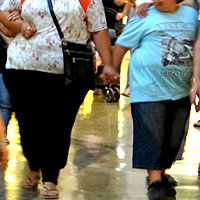
The World Health Organisation indicates that 155 million school-aged children globally are overweight or obese. In the United Kingdom, around a third of children aged two to 15 are classified as falling into these unhealthy weight categories.
Medical professionals identify childhood overweight and obesity as a body mass index greater than the 85th (overweight) and 95th (obesity) percentile. These criteria are based on population-based studies of children across the world that indicate children with a BMI above these thresholds are at increased risk of developing poor health and co-morbidities such as type 2 diabetes and risk factors for cardiovascular disease such as high blood pressure and high cholesterol.
However, results from a recent study led by the London School of Hygiene and Tropical Medicine (LSHTM) and the Institute of Child Health, University College London (UCL), suggest parents are unable to recognise when children reach this clinical threshold at which the risk of poor health is increased.
The study asked parents from almost 3,000 families for their views about whether their child was underweight, a healthy weight, overweight or obese. Parents’ perceptions were compared with objective assessments of body mass index on the same day. The results indicated that almost a third of parents believed their child to be of a healthy weight (or even underweight) when they were actually overweight or obese.
So why might parents be unable to identify that their child is overweight or obese? Perhaps parents are reluctant to recognise their child is of an unhealthy weight for fear of being judged. Similarly, they may be concerned that their child will react negatively to being classified as overweight or obese owing to the stigma attached to the use of these terms.
The results of the LSHTM and UCL study might also illustrate how overweight and obesity has become ‘normalised’ within society. With the gradual increases seen in the average population BMI over the last few decades, it appears to be increasingly difficult to distinguish between a healthy weight and an individual who may be at risk of poor health because of excess body fat. In addition, the way weight is portrayed by the media may have contributed towards many perceiving overweight and obesity as the norm. The Chief Medical Officer, Dame Sally Davies, highlighted this issue in her annual report last year, stating: ‘News stories about weight often feature pictures of severely obese people, which are unrepresentative of the majority of overweight people.’
The apparent divergence between parents’ perceptions of their child’s weight status and the BMI categories used to clinically diagnose overweight and obesity by medical professionals suggests that parents might need help to recognise when their child is of an unhealthy weight. Where parents are unable to identify their child as being overweight or obese, they may be unlikely to make changes to help their child transition to a more healthy weight. Certainly, if a parent does not believe their child is overweight, why would they encourage them to eat more healthily or be more physically active?
It therefore seems that a first step toward counteracting the childhood obesity epidemic will involve educating parents on what a healthy weight looks like. The recent findings reported by LSHTM and UCL may therefore help to inform the development of public health campaigns that address this initial barrier to a child’s healthy weight maintenance. Campaigns that include initiatives that inform parents not only why it is important to monitor their child’s weight status but also how they can do so will help to bridge the gap between parental perceptions and medical reality.
Dr Sally Fenton, Research Fellow, School of Sport, Exercise and Rehabilitation Sciences, University of Birmingham